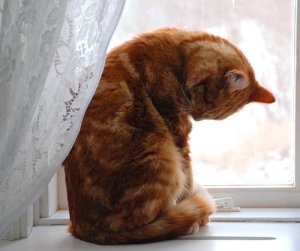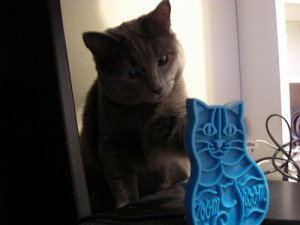How to Prevent Nasty Hairballs!
January 31, 2010 by LaBecs
Filed under How to Prevent Nasty Hairballs!
Watch any cat for a few minutes, and if he or she’s awake, you’ll see them grooming themselves with the help of their rough pink tongue. While this is a natural part of cat behavior, it is also the main cause of hairballs.
A hairball is just what it sounds like: a ball of hair. The technical term is trichobezoar. If you get hair in your mouth, you can just spit it out. But you cat can’t do that. Instead, she has to swallow the hair that comes off on her tongue during grooming. The bad news is hair can’t be digested.
Normally that’s not a problem either. The hair can still pass through the digestive tract and come out as part of the waste. However, sometimes the hair builds up in the stomach and can’t pass through the cat’s intestines. When that happens, the only way your cat can get rid of the nasty ball of hair is by throwing up!
Although seeing a cat vomit can be a disgusting and nauseating process to witness (the sounds alone make some pet owners gag), it’s better than the alternative. When your cat can’t throw up the hairball, they could end up with an obstruction that could be life-threatening and require surgery. Most feline owners would rather clean up a disgusting hairball then watch their beloved pets go under the knife.
But, thankfully, we have more options. We can actually prevent the formation of hairballs and reduce the risk of complications. Here are three tips that can help you help your cat.
Method #1: Reduce Excessive Hair
 When your cat is shedding a lot or needs a good brushing, he or she is more likely to develop hairballs that will need to be coughed up. You can help by spending time each day brushing your cat. Some cats love being brushed and will actually beg you to do it. Others aren’t crazy about being restrained and brushed so they are more resistant. But you can teach your cat to like getting groomed. Over time, even the most reluctant cat usually learns to love being brushed. Besides helping get rid of too much hair, regularly brushing reduces the amount of shedding your cat does (that’s good news for your furniture and clothes) and provides you with a great opportunity for bonding.
When your cat is shedding a lot or needs a good brushing, he or she is more likely to develop hairballs that will need to be coughed up. You can help by spending time each day brushing your cat. Some cats love being brushed and will actually beg you to do it. Others aren’t crazy about being restrained and brushed so they are more resistant. But you can teach your cat to like getting groomed. Over time, even the most reluctant cat usually learns to love being brushed. Besides helping get rid of too much hair, regularly brushing reduces the amount of shedding your cat does (that’s good news for your furniture and clothes) and provides you with a great opportunity for bonding.
Method #2: Give Special Treats as treatment
If you look at the treat section of your pet store, you’ll probably find some specially formulated treats designed to help break down hairballs in your cat’s stomach. Most of these treats come in delicious flavors – at least as far as your cat is concerned – so they eat them well. This might be a good idea if you notice your cat coughing up a lot of hairballs, or even just coughing without throwing anything up.
Method #3: Pass the Hairball
Sometimes a stubborn hairball can use a little help. Most pet stores also carry petroleum-based products that can be used to lubricate the cat’s hairball and intestines to make its passage easier. These products are 100% safe and come in cat-friendly flavors. Sometimes they can be added to the cat’s food.
A combination of all these methods can help control your cat’s hairball problem and can prevent life-threatening complications. And for you, the advantage is that you’ll spend more time grooming your cat, and less time cleaning up.
How to Make Your Cat Love Getting Groomed
July 13, 2009 by LaBecs
Filed under How to Make Your Cat Love Getting Groomed
Regularly grooming your cat can help reduce hair ball problems and can ensure that your cat’s coat continues to look healthy and beautiful. However, not all cats enjoy getting groomed. Some love being brushed and can even get a little bit demanding about their regular grooming time. Geisha, my long hair calico is very vocal about this…. trust me. Others would prefer to keep their distance from the brush permanently.

Tisha and her Zoom Groom
So, grooming a cat can be difficult. But even a resistant cat can be taught to enjoy grooming. The key is to utilize the cat’s enjoyment of human contact. The most aloof cat enjoys some great periods of petting, but some have parts of their body that are more sensitive, and they don’t want to be touched, especially not with a brush.
Understanding Your Cat’s Reluctance
Before you can change your cat’s negative attitude towards grooming, you need to understand what causes it. First, you should realize that cats, just like people, have sensitive parts in their bodies. The cat may have been injured at some point or maybe just does not like being touched in a specific area. This is why it’s important to know your cat before you begin grooming. If you know which parts of your cat’s body are sensitive, you can avoid those areas and still provide what he or she needs.
If you bring a new cat home that hasn’t had a lot of grooming before, you may want to work slowly and get her used to it. Spend a few minutes each day stroking or brushing your cat gently and make sure to give her some type of reward afterward. You want her to think the grooming is pleasurable. Avoid any trouble spots as much as possible, too.
Another issue that might cause your cat’s reluctance to submit to grooming is a dominant personality. When cats have dominant personalities, they might refuse to let you touch some parts of their body touched as well, particularly the head and neck. Now, if you’re not sure whether your cat is resisting because he or she is nervous or dominant, think about some of your cat’s other traits:
- Does the cat make direct eye contact with you?
- Does your cat jump on people as a way of showing affection?
- Does your cat not like to be in a “down” position?
If you answered yes to any or all of these questions, your cat is probably dominant.
As I mentioned above, the key here is to help your cat enjoy being groomed. To do this, you have to first figure out how long your cat takes to get upset by your actions. Pay attention to his body language. As soon as you start feeling him get tense, stop. The key is to spend a small amount of time doing the grooming, and stopping just before your cat passes that threshold, this way, you can continue showing him that grooming is a pleasant experience.
Here are a few additional tips to help your cat love being groomed:
- Do the grooming sessions before feeding your cat so you can use the food as a reward and as a way to bond with your cat
- Let the cat play with the comb if he or she wants to
- Alternate brushes with the comb and strokes with your hand to help your cat feel more at ease
- Set your grooming sessions in the afternoon when your cat is most relaxed
- Talk to him or her while you brush, this will also serve as a bonding experience.
Pick the Right Tools
There are a number of brushes and combs on the market designed specifically for cats, but some of these tools can be quite painful for them, despite what it says on the packaging. Using them can make a reluctant cat even more fearful of grooming. A long hair cat might adore being brushed with a wire brush, but a short haired cat might prefer a grooming glove (my short hairs absolutely love the glove!).All of them, long and short haired, love the Zoom Groom!
Whichever brush they choose, you will be doing your cat or cats a favor if you get them used to getting groomed often. It will make them look beautiful and help them with any hairball problems they might have.

